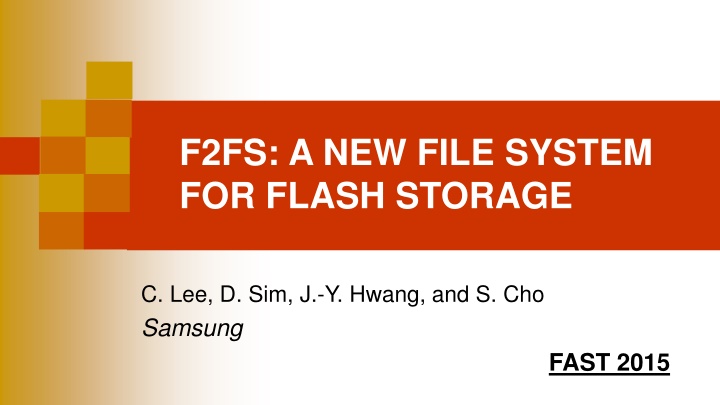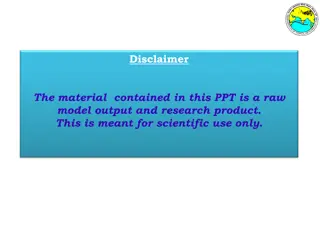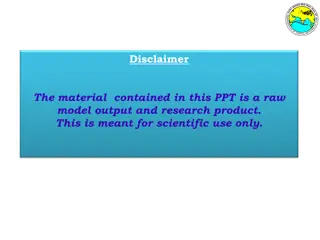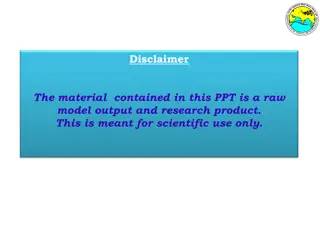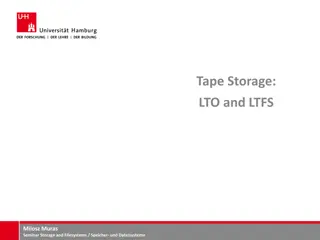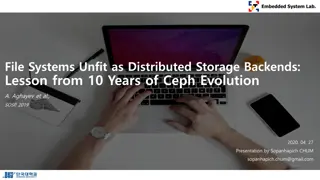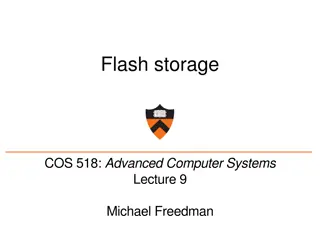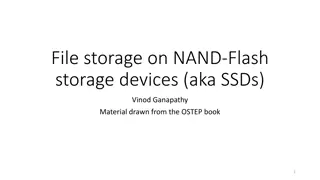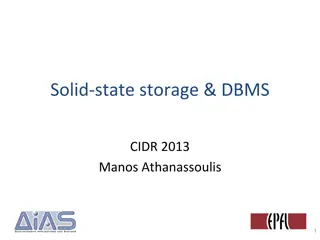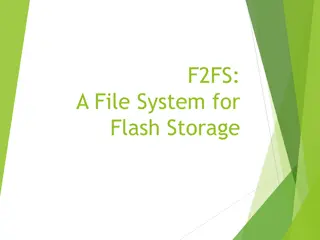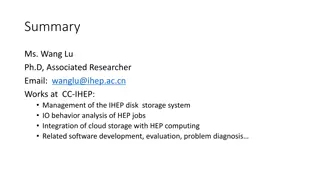F2FS: A NEW FILE SYSTEM FOR FLASH STORAGE
A look at F2FS, a Linux-compatible file system designed for NAND flash drives. It addresses issues such as internal fragmentation and sustained performance degradation in mobile applications like Facebook and Twitter. The system implements flash translation layers and wear leveling to enhance performance and longevity.
Download Presentation

Please find below an Image/Link to download the presentation.
The content on the website is provided AS IS for your information and personal use only. It may not be sold, licensed, or shared on other websites without obtaining consent from the author.If you encounter any issues during the download, it is possible that the publisher has removed the file from their server.
You are allowed to download the files provided on this website for personal or commercial use, subject to the condition that they are used lawfully. All files are the property of their respective owners.
The content on the website is provided AS IS for your information and personal use only. It may not be sold, licensed, or shared on other websites without obtaining consent from the author.
E N D
Presentation Transcript
F2FS: A NEW FILE SYSTEM FOR FLASH STORAGE C. Lee, D. Sim, J.-Y. Hwang, and S. Cho Samsung FAST 2015
Paper highlights Presents a Linux-compatible file system for NAND flash drives Log-structured file system i-node map is not on the log(s) i-node map keeps track of the location of indirect blocks Solves the wandering tree problem Data stored on multiple logs According to their hotness factor Better segment cleaning
NAND flash Started by using bare flash memory Added a dedicated flash controller Can manage multiple flash chips Implements a flash translation layer (FTL) Logical block mapping Wear levelling Page cleaning
Remaining issues Frequent random writes Incur internal fragmentation Degrade sustained performance Very common in mobile applications Facebook, Twitter, use SQLite Many fsync calls Will Affect SSD write latency Reduce the devise lifetime
Two solutions Use Log-structured file system Copy-on-write Conventional log-structured file systems Much better but still sub-optimal Ignore specifics of NAND flash media
F2FS Highlights (I) Flash-friendly on-disk organization Segments sections zones New i-node structure Revamped i-node map At fixed location Node address table Contains addresses of both i-nodes and indirect blocks Avoids wandering tree problem
F2FS Highlights (II) Multi-head logging Up to six active log segments To separate hot and cold data Adaptive logging Append-only logging Normal case Threaded logging High storage utilization
F2FS Highlights (II) fsync optimization with roll-forward recovery fsync does not trigger a checkpoint Only updates data blocks and indirect blocks containing block addresses (direct nodes) Leaves a flag inside other indirect blocks (indirect nodes) Roll-forward recovery takes care of everything Updates indirect blocks and other metadata
F2FS status A part of the Linux kernel since 3.7.1 Used in several commercial products Motorola Mobility, Google, Huawei and ZTE phones See Wikipedia entry https://en.wikipedia.org/wiki/F2FS
The six areas (I) Superblock Two copies unchanged from SSD format time Checkpoint Area Two checkpoint packs File system status Bitmaps for valid NAT and SIT sets Orphaned inode lists Summary entries of currently active segments
The six areas (II) Segment information table (SIT) Number of valid blocks in each segment Bitmaps identifying these valid segments Node address table (NAT) i-node map on steroids Contains addresses of i-nodes Indirect blocks (direct nodes and indirect nodes)
The six areas (III) Segment summary area (SSA) Keeps track of owner information for all blocks in main area Parent i-node , offset, Main area 4KB blocks Can be Node blocks Ordinary data blocks
Looking up for /dir/file Get address of root i-node block from NAT Search for dir entry in data blocks of root i-node Get i-node number for dir Get address of dir i-node block from NAT Search for file entry in data blocks of root i-node Get i-node number for file Get address of file i-node block from NAT
File structure Node address table has addresses of i-nodes Indirect blocks containing addresses of data blocks Direct nodes Indirect blocks containing addresses of other indirect blocks Indirect nodes
F2FS file structure (II) Larger i-nodes Plenty of direct block addresses or 3,682 bytes of direct data (copied from NTFS) Two single-indirect pointers Two double-indirect pointers One triple indirect pointer 200 bytes for extended attributes
Motivation i-node and indirect nodes replace other node addresses by their indexes (node IDs) i-nodes contain both block addresses and node IDs Indirect nodes contain node IDs Direct nodes contain block addresses
A conventional LFS i-node 0 1 1 2 3 11 12 13 14 Other stuff Triple indirection blocks blocks blocks Data
We update a data block (I) i-node 0 1 1 2 3 11 12 13 14 Other stuff Triple indirection blocks blocks Updated data block at new address blocks Data
We update a data block (II) i-node 0 1 1 2 3 11 12 13 14 Other stuff Triple indirection blocks Updated address block at new address blocks Updated data block at new address blocks Data
We update a data block (III) i-node 0 1 1 2 3 11 12 13 14 Other stuff Triple indirection blocks Updated address block at new address Updated address block at new address blocks Updated data block at new address blocks Data
We update a data block (IV) Updated i-node i-node 0 1 1 2 3 11 12 13 14 Other stuff Triple indirection blocks Updated address block at new address Updated address block at new address blocks Updated data block at new address blocks Data
The F2FS solution i-node 0 1 1 2 3 11 12 13 14 Other stuff Triple indirection blocks blocks blocks Data
We update a data block (I) i-node 0 1 1 2 3 11 12 13 14 Other stuff Triple indirection blocks blocks blocks Data
We update a data block (II) i-node 0 1 1 2 3 11 12 13 14 Other stuff Triple indirection blocks Updated direct node at new address keeps its ID Must now update address of direct node in NAT blocks blocks Data
Directory structure 4KB directory entries contain A bitmap Two arrays of slots and names Bitmap entries identify valid slots Slots contain A hash , a i-node number, the file name length and type Directories are organized as multilevel hash tables Allows O(log # of dentries) searches
Multi-head logging Typically six separate logs Used to separate hot and cold blocks F2FS identifies has cold Data blocks that have been moved by the segment cleaner Data blocks labelled as cold by their owner Multimedia file data
FTL issues Must take into account characteristics of Flash Translation Layer F2FS maps active logs to different zones to separate tem in the FTL
Cleaning Can be Foreground Only when there are not enough free sections Background
Main cleaning steps Identifying the victim section Greedy policy for foreground cleaning Minimizes delay Cost-benefit for background cleaning Valid block identification and migration Per-segment validity bitmap in Segment Information Table Background cleaning does not issues writes to migrate valid blocks Puts them in I/O cache and marks tem dirty
Adaptive logging Append-only logging Normal case Just like Sprite LFS Threaded logging High storage utilization
fsyncoptimization fsync does not trigger a checkpoint Only updates data blocks and indirect blocks containing block addresses (direct nodes) Leaves a flag inside other indirect blocks (indirect nodes) Roll-forward recovery takes care of everything Updates indirect blocks and other metadata
Performance evaluation Four benchmarks on a mobile system Four benchmarks on a server Compare them with EXT 4 (JFS) BTRFS (copy-on-write file system) NILFS2 (log structured file system)
Other observations Write amplification factor is not dramatically increased at high utilization levels Adaptive logging is essential
